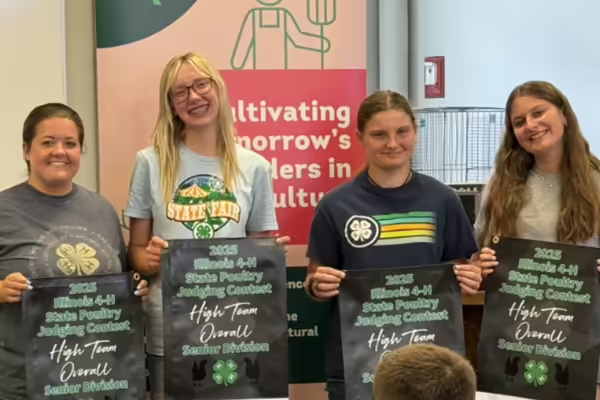
Urbana, Ill. -- Illinois 4-H members headed to the showring for the 2025 Illinois 4-H Poultry Judging Contest held at the University of Illinois campus on Jun. 25. This state contest provides youth with hands-on experience in evaluating poultry and eggs based on industry standards. Participants gain valuable knowledge about quality, safety, and nutrition in poultry and egg production, key skills that support a safe and reliable food supply. Youth put their skills to the test as they competed for top honors in this educational and rewarding statewide event.
“This event helps youth develop skills in observation, critical thinking, and decision-making - skills that will benefit them far beyond their time in the 4-H program,” said Myla Munro, 4-H Youth Development Educator and contest coordinator. “We're proud of every youth who participated and demonstrated their knowledge, confidence, and attention to detail.”
The four highest senior 4-H’ers were selected to participate on the state team. A senior 4-H’er is one who is 14-18 years of age by January 1 of the current year. The individuals who scored the highest were invited to participate in the National 4-H Poultry and Egg Conference during the third week of November in Louisville, KY.
The results of the 2025 Illinois 4-H Poultry Judging Contest include:
Senior Individual Placings:
Kari Weir in 1st place from DuPage County, Olivia Whitlock in 2nd place from Adams County, Mariah Mintle in 3rd place from Adams County, Lydia Worsham in 4th place from DeWitt County, Brinley Hackamack in 5th place from Adams County, Matthew Selucky in 6th place from Will County, Chloe Miller in 7th place from Will County, and Emily Pierce in 8th place from Will County.
Junior Individual Placings:
Austin Ater in 1st place from Champaign County, Kolby Shaffer in 2nd place from Adams County, Brandon Wier in 3rd place from DuPage County, Easton Barney in 4th place from Will County, Blake Hackamack in 5th place from Adams County, and Danika Shaffer in 6th place from Adams County.
Senior Team Placings:
Adams County in 1st place and Will County in 2nd place.
Junior Team Placings:
Adams County in 1st place.
To learn more about youth poultry programming, contact your local Extension Office.
Source: Myla Munro, 4-H Youth Development Educator
Writer: Sophia Schneider, Communications Intern, 4-H State Office, sschn1@illinois.edu
About Illinois 4-H: About Illinois 4-H:
Illinois 4-H is the flagship youth development program of University of Illinois Extension, administered through the College of Agricultural, Consumer and Environmental Sciences. Through hands-on learning and life-changing experiences, Illinois 4-H prepares youth to be Beyond Ready — ready for college, career, military service, entrepreneurship, and more. Young people build confidence, leadership, and resilience as they explore interests from agriculture to computer science. Independent research and national surveys confirm the powerful outcomes of 4-H: participants are 40% more likely to pursue a college degree, twice as likely to obtain technical training, and two times more likely to serve in the military. With a legacy of cultivating leaders, Illinois 4-H continues to grow the next generation who are equipped to thrive in life and work today and beyond.
About Extension: Illinois Extension leads public outreach for University of Illinois by translating research into action plans that allow Illinois families, businesses, and community leaders to solve problems, make informed decisions, and adapt to changes and opportunities.
University of Illinois Extension develops educational programs, extends knowledge, and builds partnerships to support people, communities, and their environments as part of the state's land-grant institution. Extension serves as the leading public outreach effort for University of Illinois Urbana-Champaign and the College of Agricultural, Consumer and Environmental Sciences in all 102 Illinois counties through a network of 27 multi-county units and over 700 staff statewide. Extension’s mission is responsive to eight strategic priorities — community, economy, environment, food and agriculture, health, partnerships, technology and discovery, and workforce excellence — that are served through six program areas — 4-H youth development, agriculture and agribusiness, community and economic development, family and consumer science, integrated health disparities, and natural resources, environment, and energy.